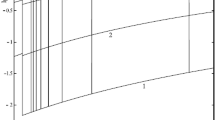Abstract
The results of spectral observations of the region of massive star formation L379IRS1 (IRAS18265–1517) are presented. The observations were carried out with the 30-m Pico Veleta radio telescope (Spain) at seven frequencies in the 1-mm, 2-mm, and 3-mm wavelength bands. Lines of 24 molecules were detected, from simple diatomic or triatomic species to complex eight- or nine-atom compounds such as CH3OCHO or CH3OCH3. Rotation diagrams constructed from methanol andmethyl cyanide lines were used to determine the temperature of the quiescent gas in this region, which is about 40–50 K. In addition to this warm gas, there is a hot component that is revealed through high-energy lines of methanol and methyl cyanide, molecular lines arising in hot regions, and the presence of H2O masers and Class II methanol masers at 6.7 GHz, which are also related to hot gas. One of the hot regions is probably a compact hot core, which is located near the southern submillimeter peak and is related to a group of methanol masers at 6.7 GHz. High-excitation lines at other positions may be associated with other hot cores or hot post-shock gas in the lobes of bipolar outflows. The rotation diagrams can be use to determine the column densities and abundances of methanol (10−9) and methyl cyanide (about 10−11) in the quiescent gas. The column densities of A- and E-methanol in L379IRS1 are essentually the same. The column densities of other observedmolecules were calculated assuming that the ratios of the molecular level abundances correspond to a temperature of 40 K. The molecular composition of the quiescent gas is close to that in another region of massive star formation, DR21(OH). The only appreciable difference is that the column density of SO2 in L379IRS1 is at least a factor of 20 lower than the value in DR21(OH). The SO2/CS and SO2/OCS abundance ratios, which can be used as chemical clocks, are lower in L379IRS1 than in DR21(OH), suggesting that L379IRS1 is probably younger than DR21(OH).
Similar content being viewed by others
References
J. Hilton and J. F. Lahulla, Astron. J. 106, 672 (1993).
M. L. Kelly and G. H. Macdonald, Mon. Not. R. Astron. Soc. 282, 401 (1996).
A. J. Walsh, M. G. Burton, A. R. Hyland, and G. Robinson, Mon. Not. R. Astron. Soc. 301, 640 (1998).
M. I. Pashchenko and A. M. le Skeren, Astron. Lett. 20, 69 (1994).
M. I. Pashchenko and E. E. Lekht, Astron. Rep. 49, 624 (2005).
J. Hilton, G. J. White, N. H. Cronin, and R. Rainey, Astron. Astrophys. 154, 274 (1986).
L. Kogan and V. Slysh, Astrophys. J. 497, 800 (1998).
V. I. Slysh, I. E. Val’tts, S. V. Kalenskii, and V. V. Golubev, Astron. Rep. 73, 785 (1999).
V. G. Promyslov, G. M. Larionov, and S. V. Kalenskii, Astron. Rep. 47, 276 (2003).
J. T. Pottage, D. R. Flower, and S. L. Davis, J. Phys. B 35, 254 (2002).
J. T. Pottage, D. R. Flower, and S. L. Davis, Mon. Not. R. Astron. Soc. 352, 39 (2004).
S. V. Kalenskii, A. V. Alakoz, and V. G. Promyslov, in Chemistry as a Diagnostic of Star Formation, Ed. by C. L. Curry and M. Fish (NRC, Ottawa, Canada, 2003), Vol. 53, p. 321.
S. Leurini, P. Schilke, K. M. Menten, D. R. Flower, J. T. Pottage, and L. H. Xu, Astron. Astrophys. 422, 573 (2004).
S. V. Kalenskii and S. Kurtz, Astron. Zh. (2016, in press).
R. M. Lees, Astrophys. J. 184, 763 (1973).
P. Friberg, Å. Hjalmarson, S. C. Madden, and W. M. Irvine, Astron. Astrophys. 195, 281 (1988).
E. S. Wirström, W. D. Geppert, Å. Hjalmarson, C. M. Persson, J. H. Black, P. Bergman, T. J. Millar, M. Hamberg, and E. Vigren, Astron. Astrophys. 533, A24 (2011).
F. F. S. van der Tak, J. H. Black, F. L. Schöier, D. J. Jansen, and E. F. van Dishoeck, Astron. Astrophys. 468, 627 (2007).
V. Hernandez-Hernandez, L. Zapata, S. Kurtz, and G. Garay, Astron. Astrophys. 568, 65 (2014).
H. G. Arce, J. Santiago-Garcia, J. K. Jorgensen, M. Tafalla, and R. Bachiller, Astrophys. J. 681, 21 (2008)
S. N. Milam, C. Savage, M. A. Brewster, L. M. Ziurys, and S. Wyckoff, Astrophys. J. 634, 1126 (2005).
H. E. Matthews and T. J. Sears, Astrophys. J. 267, 53 (1983).
S. V. Kalenskii, V. G. Promyslov, A. V. Alakoz, A. Winnberg, and L. E. B. Johansson, Astron. Rep. 44, 725 (2000).
S. R. Purcell, R. Balasubramanyam, M. G. Burton, A. J. Walsh, V. Minier, M. R. Hunt-Cunningham, L. L. Kedziora-Chudczer, S. N. Longmore, T. Hill, I. Bains, P. J. Barnes, A. L. Busfield, P. Calisse, N. H. M. Crighton, S. J. Curran, et al., Mon. Not. R. Astron. Soc. 367, 553 (2006).
S. V. Kalenskii and L. E. B. Johansson, Astron. Rep. 54, 1084 (2010).
A. Bacmann, V. Tarquet, A Faure, C. Kahane, and C. Ceccarelli, Astron. Astrophys. 541, L12 (2012).
C. Vastel, C. Ceccarelli, B. Lefloch, and R. Bachiller, Astrophys. J. 795, L2 (2014).
K. I. öberg, S. Bottinelli, J. K. Jorgensen, and E. F. van Dishoeck, Astrophys. J. 716, 825 (2010).
A. Jaber, C. Ceccarelli, C. Cahane, and E. Caux, Astrophys. J. 791, 29 (2014).
J. G. Mangum and Y. L. Shirley, Publ. Astron. Soc. Pacif. 127, 266 (2015)
H. Ungerechts, G. Winnewisser, and C. M. Walmsley, Astron. Astrophys. 157, 207 (1986).
S. V. Kalenskii and L. E. B. Johansson, Astron. Rep. 54, 295 (2010).
V. Wakelam, P. Caselli, C. Ceccarelli, E. Herbst, and A. Castets, Astron. Astrophys. 422, 159 (2004).
V. Wakelam, F. Hersant, and F. Herpin, Astron. Astrophys. 529, A112 (2011).
Author information
Authors and Affiliations
Corresponding author
Additional information
Original Russian Text © S.V. Kalenskii, M.A. Shchurov, 2016, published in Astronomicheskii Zhurnal, 2016, Vol. 93, No. 4, pp. 409–432.
Rights and permissions
About this article
Cite this article
Kalenskii, S.V., Shchurov, M.A. A study of the region of massive star formation L379IRS1 in radio lines of methanol and other molecules. Astron. Rep. 60, 438–460 (2016). https://doi.org/10.1134/S1063772916020049
Received:
Accepted:
Published:
Issue Date:
DOI: https://doi.org/10.1134/S1063772916020049




